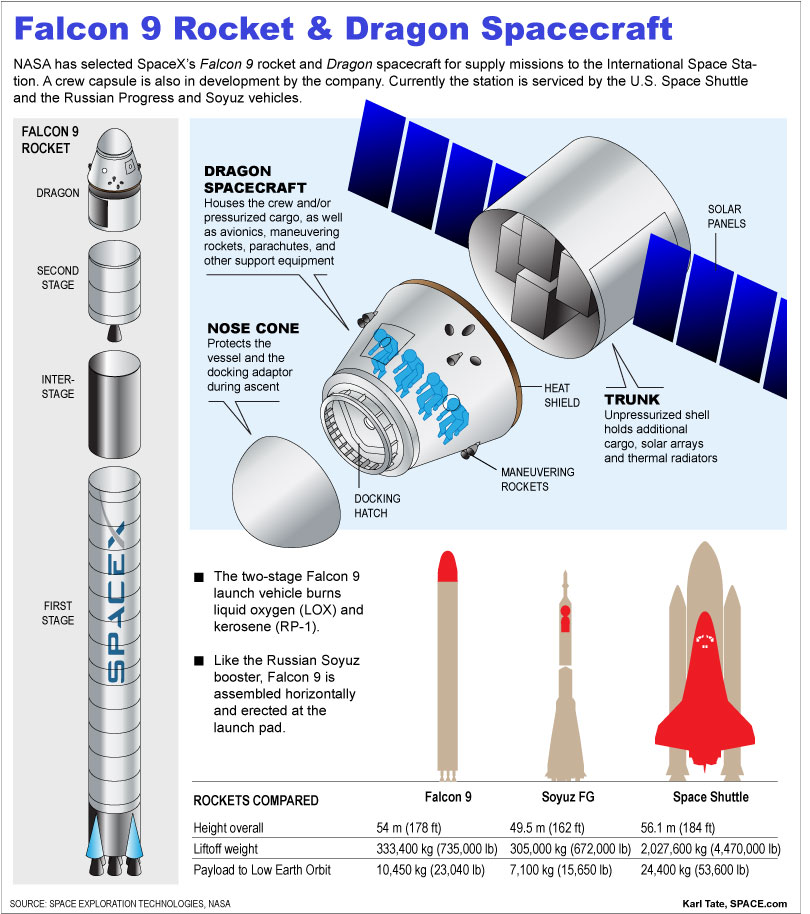New Private Rocket's Launch Debut Slips to June

WASHINGTON —The inaugural test launch of a new commercial rocket has slipped from May 28 tono earlier than June 2, according to its builder Space Exploration Technologies(SpaceX).
The first Falcon 9 rocket, assembled on theSpaceX launch pad at Cape Canaveral Air Force Station in Florida, is awaitingU.S. Air Force approval of its flight termination system, an explosive chargedesigned to destroy the rocket if it veers off course during launch.
But theHawthorne, Calif.-based company attributed the most recent delay of the Falcon 9launch debut to changes in the Cape's crowded manifest.
"Lookslike the delay of the [Air Force Delta 4] GPS satellite launch has taken up alot of resources at the Cape and in turn pushed the first test launch of Falcon9 from May 28/29 to no earlier than June 2/3," SpaceX spokeswoman EmilyShanklin said in an e-mail sent to reporters late Tuesday.
The AirForce has been trying to launch the new GPS satellite since last week. Butweather and technical delays have prevented the satellite's Delta 4 rocket fromlaunching from the Cape Canaveral Air Force Station. They also forced the AirForce to wait until after NASA's space shuttle Atlantis landed today to tryagain.
The Delta 4rocket is currently slated to make another launch attempt late Thursday, May27.
The firstFalcon 9 rocket will carry a qualification version of SpaceX's Dragoncapsule, which is designed to carry cargo, and potentially humans intoorbit and the International Space Station. Under a $1.6 billion NASA contractawarded in 2008, Dragon and Falcon 9 are set to begin delivering cargo to the spacestation beginning in 2011. [Graphic: SpaceX's Falcon 9 andDragon.]
Get the Space.com Newsletter
Breaking space news, the latest updates on rocket launches, skywatching events and more!
SpaceX'smedium-lift Falcon 9 rocket is a two-stage booster. It stands 180 feet (55meters) tall and is about 12 feet (3.6 meters) wide, with a first stage poweredby nine of SpaceX's own Merlin rocket engines fueled by liquid oxygen androcket-grade kerosene.
NASA isbanking on the success of SpaceX's Falcon 9 rocket and its Dragon spacecraft,as well as other commercial spacevehicleefforts.
The U.S.space agency plans to retire its three space shuttles later this year and useunmanned commercial spacecraft to ferry supplies to the space station untilprivately built crew-carrying vehicles become available in the next five yearsor so.
- Gallery: SpaceX's Falcon 9 Rocket Photos
- The Best Manned Spaceships of All Time
- Video — SpaceX's Vision for Manned Dragon Spaceship
SPACE.com Staff contributed to this report from New York City.
Join our Space Forums to keep talking space on the latest missions, night sky and more! And if you have a news tip, correction or comment, let us know at: community@space.com.
Amy Klamper is a space reporter and former staff writer for the space industry news publication SpaceNews. From 2004 to 2010, Amy covered U.S. space policy, NASA and space industry professionals for SpaceNews. Her stories included profiles on major players in the space industry, space policy work in the U.S. Senate and House of Representatives, as well as national policy set by the White House.









